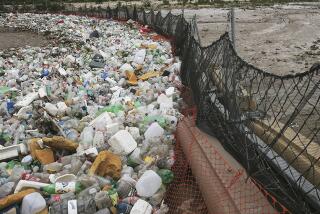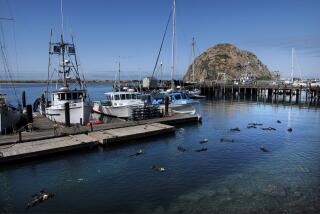San Diego Misses Brunt of Bush’s Budget Cutbacks : Economy: Military trims will be restrained, but the cost of a border sewage plant is expected to double.
WASHINGTON — Despite a stubborn recession and fears of possible cutbacks, the proposed Bush Administration budget released Wednesday spared San Diego from any dramatic economic reversals.
But the budget also noted that the cost of building a plant at the U.S.-Mexico border to treat sewage from Tijuana has ballooned to almost $407 million, double original estimates.
The Administration late last week indicated that increased funds were earmarked for controlling border pollution and assisting cities in coping with the costs of illegal immigration over the Mexican border.
Despite the continuing scaling back of defense spending, no major cuts in the varied military presence in San Diego County were announced. San Diego has actually gained 15,000 military and civilian jobs as the Defense Department has consolidated commands over the past few years.
Bush’s plan to halt further production of the Advanced Cruise Missile comes as a blow to contractor General Dynamics, but the company said Wednesday that work on already-purchased missiles will keep the San Diego program going for several more years. No immediate layoffs are being considered, the company said.
One of the key budgetary variables for San Diego, the details of the military construction budget, were not available Wednesday, according to Rep. Bill Lowery (R-San Diego), ranking minority member on the Appropriations Military Construction Subcommittee. The specific budget figures will be released next week, but Lowery was reasonably confident that the region will not be hit hard.
Lowery said the Defense Department had earlier signaled a “strategic pause” in the military construction budget, but the figures released Wednesday indicate that threat is not being carried out.
“Overall, there is $6.2 billion in general construction and more than $4 billion in family housing construction for the military,” Lowery said. “If these figures are maintained, there should be a substantial increase in the amount of construction and jobs coming to the San Diego area.”
The International Thermonuclear Experimental Reactor is scheduled to receive part of an $18-million increase in the Department of Energy’s magnetic fusion research program. The ITER project has its U.S. base at UC San Diego, and the European Community, Japan and the former Soviet Union are cooperating partners in the venture.
A $26-million, 1,000-bed detention facility for criminal aliens has been funded as a joint project of the U.S. Immigration and Naturalization Service and the Bureau of Prisons. An INS spokesman said the actual site of the prison has not been determined but that the San Diego region is still under consideration, along with sites in Arizona.
The INS is expected to spend $10 million to begin construction of a new San Clemente border checkpoint, although that figure was not listed as a line item, and the Oceanside sand bypass project is budgeted to receive $628,000 for operation and maintenance.
Oceanside Harbor was designated for $2.6 million in construction funds, with an additional $85,000 for maintenance and dredging.
And a shoreline erosion study in Carlsbad was budgeted for $350,000.
Last week, the Administration revealed Bush’s plan to seek $201 million for sewage and pollution control at the border, nearly double the $103 million approved last year. The added funds are part of the Administration’s strategy of winning over environmentalists who fear the North American Free Trade Agreement will stimulate commerce and worsen the already-severe pollution problems in the border region.
The President is asking for a total of $69 million to build the San Diego-Tijuana sewage treatment plant, the key facility in the battle to control across-the-border Mexican sewage flows that have plagued San Diego beaches and coastal properties for nearly half a century. Last year, Bush asked for $100 million for the plant, and $49 million was finally appropriated.
The U.S. Environmental Protection Agency now estimates the plant will cost $406.6 million to build, more than twice the $194 million of early projections.
The price tag ballooned because of several major design changes. The most expensive alteration would be a $97-million extension of the ocean outfall--the pipe that dumps the treated water into the sea. Originally positioned at 1 mile out, the outfall now is designed to extend 3 1/2 miles into the ocean.
The EPA has also redesigned the plant to handle stronger effluent than originally anticipated. Now the plant will be engineered to accommodate “high-strength and variable toxic pollutants,” according to the EPA. This change will increase costs by $78 million, the agency said.
Protecting the existing Tijuana Estuary from the adverse effects of plant construction would add $9 million to the overall costs, the EPA said. The International Boundary and Water Commission, a binational organization that oversees border affairs, had earlier predicted that no environmental mitigation would be necessary during construction.
For decades, raw sewage from Tijuana has flowed northward across the border via the Tijuana River and numerous gullies and arroyos. Tijuana’s system of sewage pipes often breaks down, and many of the city’s residents have no regular plumbing.
Bush is also including $40 million to upgrade San Diego’s outdated sewage treatment plant. The money is part of $340 million in grants for major coastal cities, including Los Angeles, Boston, New York, Baltimore and Seattle, to bring their treatment plants up to federal Clean Water Act standards.
San Diego fought the U.S. government on the sewage plant upgrade, which was supposed to have been completed by July, 1988. After being sued by three state and federal agencies when the deadline expired, the city approved an out-of-court settlement and promised to finish the improvements by the end of 2003, though the matter is still pending in federal court.
Waste water reaching the city’s main sewage plant at Point Loma now receives “advanced primary” treatment. Federal law requires upgrading to “secondary” standards, which are about 10% more effective in cleaning waste water.
The budget also calls for $10 million for cleaning up pollution from the New River in Mexicali, Mexico, across the border from Calexico in Imperial County.
* CRUISE MISSILE program cutbacks will hurt General Dynamics. B1
More to Read
Get the L.A. Times Politics newsletter
Deeply reported insights into legislation, politics and policy from Sacramento, Washington and beyond. In your inbox three times per week.
You may occasionally receive promotional content from the Los Angeles Times.










